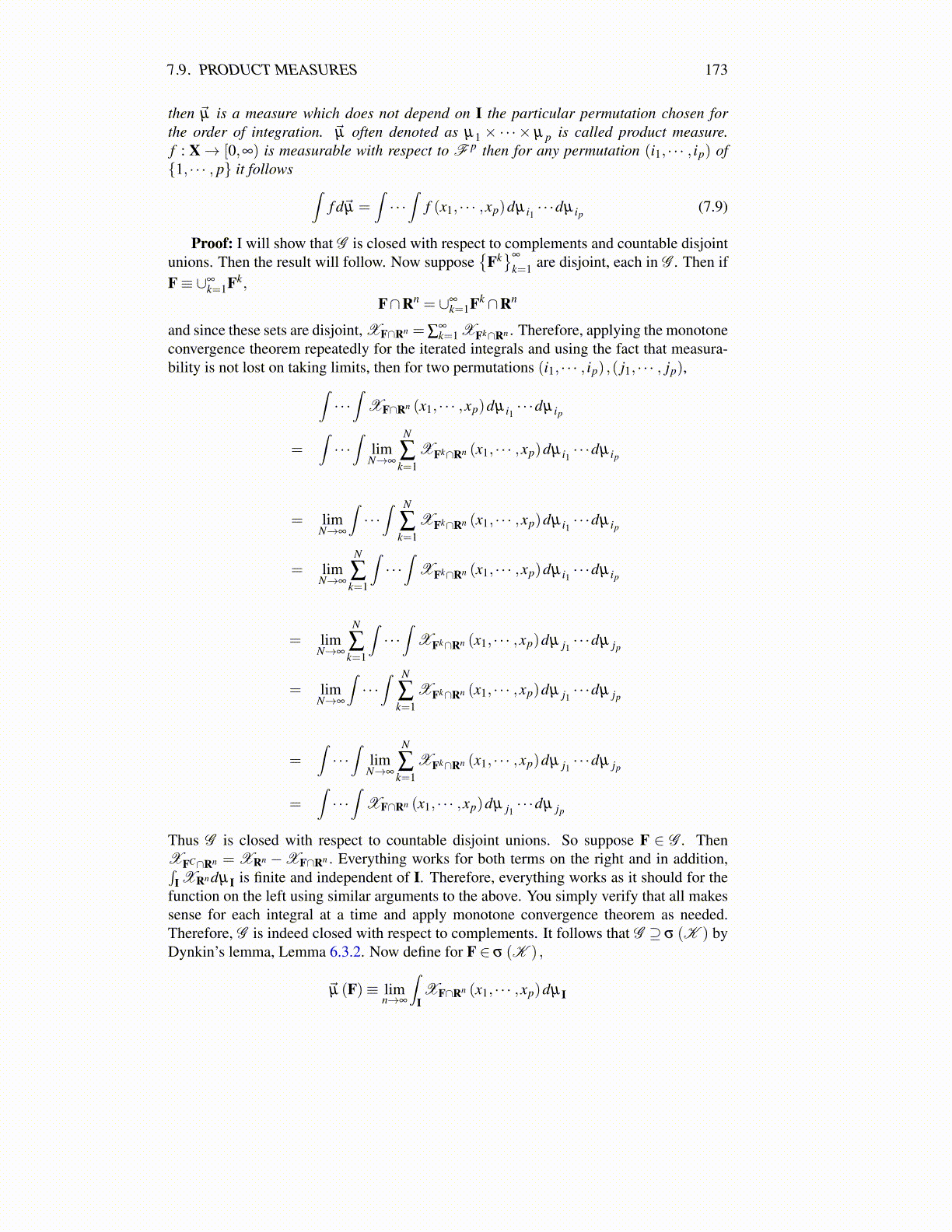
7.9. PRODUCT MEASURES 173
then µ⃗ is a measure which does not depend on I the particular permutation chosen forthe order of integration. µ⃗ often denoted as µ1 × ·· · × µ p is called product measure.f : X→ [0,∞) is measurable with respect to F p then for any permutation (i1, · · · , ip) of{1, · · · , p} it follows ∫
f dµ⃗ =∫· · ·∫
f (x1, · · · ,xp)dµ i1 · · ·dµ ip(7.9)
Proof: I will show that G is closed with respect to complements and countable disjointunions. Then the result will follow. Now suppose
{Fk}∞
k=1 are disjoint, each in G . Then ifF≡ ∪∞
k=1Fk,
F∩Rn = ∪∞k=1Fk ∩Rn
and since these sets are disjoint, XF∩Rn =∑∞k=1 XFk∩Rn . Therefore, applying the monotone
convergence theorem repeatedly for the iterated integrals and using the fact that measura-bility is not lost on taking limits, then for two permutations (i1, · · · , ip) ,( j1, · · · , jp),∫
· · ·∫
XF∩Rn (x1, · · · ,xp)dµ i1 · · ·dµ ip
=∫· · ·∫
limN→∞
N
∑k=1
XFk∩Rn (x1, · · · ,xp)dµ i1 · · ·dµ ip
= limN→∞
∫· · ·∫ N
∑k=1
XFk∩Rn (x1, · · · ,xp)dµ i1 · · ·dµ ip
= limN→∞
N
∑k=1
∫· · ·∫
XFk∩Rn (x1, · · · ,xp)dµ i1 · · ·dµ ip
= limN→∞
N
∑k=1
∫· · ·∫
XFk∩Rn (x1, · · · ,xp)dµ j1 · · ·dµ jp
= limN→∞
∫· · ·∫ N
∑k=1
XFk∩Rn (x1, · · · ,xp)dµ j1 · · ·dµ jp
=∫· · ·∫
limN→∞
N
∑k=1
XFk∩Rn (x1, · · · ,xp)dµ j1 · · ·dµ jp
=∫· · ·∫
XF∩Rn (x1, · · · ,xp)dµ j1 · · ·dµ jp
Thus G is closed with respect to countable disjoint unions. So suppose F ∈ G . ThenXFC∩Rn = XRn −XF∩Rn . Everything works for both terms on the right and in addition,∫
I XRndµI is finite and independent of I. Therefore, everything works as it should for thefunction on the left using similar arguments to the above. You simply verify that all makessense for each integral at a time and apply monotone convergence theorem as needed.Therefore, G is indeed closed with respect to complements. It follows that G ⊇ σ (K ) byDynkin’s lemma, Lemma 6.3.2. Now define for F ∈ σ (K ) ,
µ⃗ (F)≡ limn→∞
∫IXF∩Rn (x1, · · · ,xp)dµI